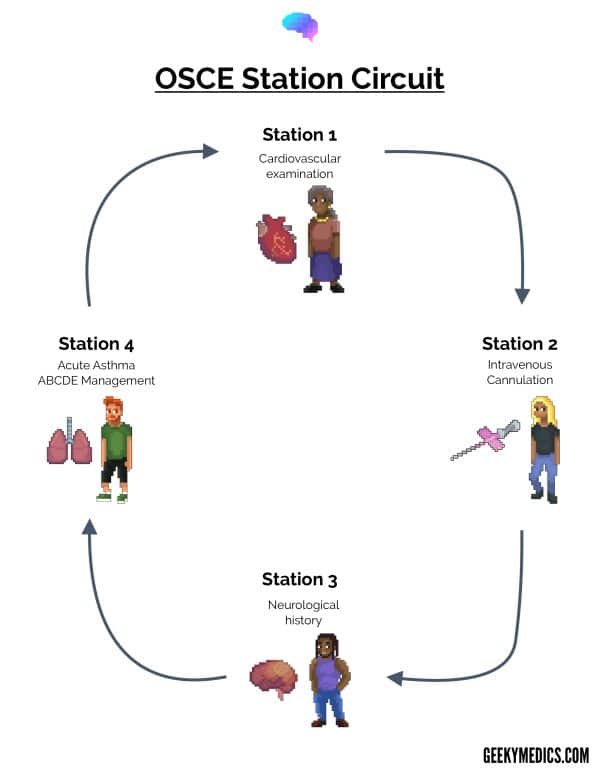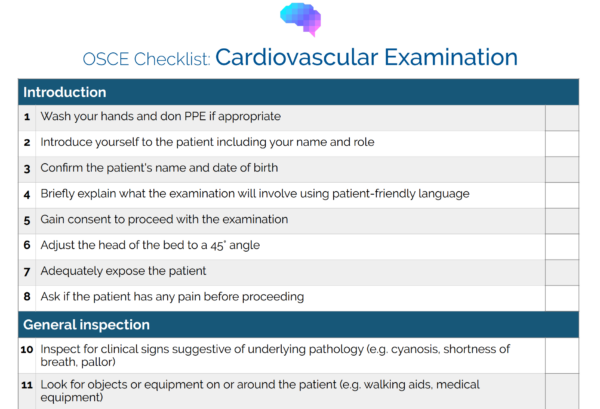- 📖 Geeky Medics OSCE Book
- ⚡ Geeky Medics Bundles
- ✨ 1300+ OSCE Stations
- ✅ OSCE Checklist PDF Booklet
- 🧠 UKMLA AKT Question Bank
- 💊 PSA Question Bank
- 💉 Clinical Skills App
- 🗂️ Flashcard Collections | OSCE, Medicine, Surgery, Anatomy
- 💬 SCA Cases for MRCGP
To be the first to know about our latest videos subscribe to our YouTube channel 🙌
OSCEs are a common method of assessment for medical and healthcare students. In this post, we’ll explain what an OSCE is and how you can prepare for any upcoming OSCEs.
What does OSCE stand for?
OSCE stands for Objective Structured Clinical Examination.
What is an OSCE?
An Objective Structured Clinical Examination (OSCE) is a common method of assessing clinical competence in medical education.
An OSCE assesses performance in a simulated clinical environment, not in an actual clinical environment. In contrast, workplace-based assessments (e.g. the mini-CEX) take place in the actual clinical environment.
An OSCE is designed to be an objective and standardised method of assessing students’ clinical competence. Candidates complete a series of timed activities (OSCE stations) in a circuit. Each station has a trained examiner who assesses the students’ performance against a standardised scoring sheet.
OSCE stations can involve real or simulated patients (either actors or mannequins).
OSCEs were originally designed for the assessment of medical students but are now commonly used to assess other healthcare students (e.g. nursing, paramedic, physician associate etc.). OSCEs are also used in postgraduate examinations in the context of higher specialty training.
Definition of an OSCE
‘‘An assessment tool based on the principles of objectivity and standardisation, in which the candidates move through a series of time-limited stations in a circuit for the purposes of assessment of professional performance in a simulated environment. At each station, candidates are assessed and marked against standardised scoring rubrics by trained assessors’’ (Khan et al, 2013)
How is an OSCE run?
An OSCE is organised around an OSCE circuit (you can see an example OSCE circuit we created here using our free OSCE station creator tool). An OSCE circuit is a set of OSCE stations that candidates rotate around. Each candidate starts at a different station and will complete all stations in the circuit.
Students move from one OSCE station to the next under guidance from staff members. Each OSCE station is time-limited, usually, a timer or buzzer is used to signal the start and end of each station.
Usually, each OSCE station has allocated time for the students to read the station instructions and don any required PPE. Some OSCE stations (for example, data interpretation) may provide additional information for students to review before they enter the station.
The OSCE is conducted under examination conditions.
Larger medical schools may run OSCEs over several days and across different venues.

What are common OSCE stations?
Common OSCE station categories include:
- Clinical examination: performing a clinical examination on a real or simulated patient
- Communication skills: history taking, information giving, breaking bad news
- Data interpretation: interpreting investigation results (e.g. X-rays, blood tests, CSF results)
- Simulation / ABCDE assessment: assessing and managing an acutely unwell patient
- Clinical procedures: performing a clinical skill (e.g. venepuncture or blood cultures)
OSCE stations should be mapped to the curriculum of the course you are completing. You should not be expected to complete a task that you haven’t been taught yet. For example, you should only be assessed on clinical procedures you have been taught.
The focus of an OSCE station may vary as you progress through the course. For example, as a junior student you may be expected to perform a clinical examination but not to interpret findings or suggest investigations and management. Senior students may be expected to interpret findings, suggest differential diagnoses and appropriate management.
Each OSCE station will have student instructions informing you of the task to be completed during the station.
Example OSCE station: cardiovascular examination
- You are a medical student on placement in the medical assessment unit
- A 24-year-old has presented for assessment with palpitations
- Please perform a cardiovascular examination
- At the end of the station, you’ll be asked to present your findings. formulate a differential diagnosis and then answer some further questions
Example OSCE station: abdominal pain history
- You are a junior doctor completing a rotation in general practice
- A 52-year-old male has presented for assessment
- Their presenting complaint is abdominal pain
- Please take a history
- At the end of the station, the examiner may ask you some further questions
How many stations are in an OSCE?
The number of OSCE stations will vary between medical schools and across different year groups. The number of stations may range from 6 – 20. The length of the OSCE stations may influence the number of stations included in the examination.
OSCEs require a significant amount of planning and coordination to design and run (for example, every station needs an examiner who are all usually practicing clinicians). This often limits the number of stations which can be run.
How much time per OSCE station?
The length of each OSCE station usually varies between 5 – 10 minutes. Occasionally, stations can be longer (15 – 20 minutes).
More complex stations (for example, history taking with documentation) are usually longer.
How is an OSCE marked?
Each OSCE station has a trained examiner who observes the student completing the task in the station.
There are two methods of OSCE marking: checklist and domain-based.
A checklist approach involves the mark sheet breaking down the individual components of the task being performed by the candidate (Figure 1). The examiner ticks the stages the candidate successfully completes.

Although checklists are objective and structured, a criticism of this approach is that it encourages students to learn the checklist rather than focusing on the actual skill or procedure.
An alternative approach is domain-based marking (also called rating scale or global rating). In this method, individual checklist items are replaced with broad categories (e.g. patient safety, physical examination etc). Examiners will also provide a global rating of your performance during the OSCE station.
Does the medical licensing assessment include an OSCE?
The General Medical Council is introducing the medical licensing assessment (MLA) from 2024. All graduates will need to pass the MLA before they can join the medical register and practice as a doctor.
The medical licensing assessment will include a clinical and professional skills assessment (CPSA) which will be run by medical schools. The CPSA may take the format of an OSCE, although the format will vary between medical schools.
How should I prepare for an OSCE?
OSCEs can be a stressful experience for students. Often, OSCEs may be a high-stakes examination where passing the examination is required to progress to the next year of study (or graduate!). In addition, performance anxiety is a common feeling and the OSCE environment can feel very intimidating.
Know what to expect
Individual medical schools will run OSCEs in different ways and should provide some information about the assessment in advance.
For example, how many stations will there be? How long is each station? Find out this information in advance so you know what to expect.
Some medical schools may provide information on the breakdown of OSCE stations (for example, how many clinical examination stations etc.).
Practice your OSCE technique
Take every opportunity to practice your OSCE technique, common methods of practising include:
- Attending clinical placement: there’s no substitute for examining, and speaking to, real patients (with their informed consent, of course!)
- Practice with peers: form a small study group to practice different OSCE stations
- Practice on non-medical friends/family: often, practising on fellow healthcare students is less realistic (as the volunteer patient knows what to expect) – try practicing on any willing non-medical friends and family, this will also be a good test of your communication skills!
- Use the clinical skills facilities: take every opportunity to practice procedural skills and simulation scenarios in the simulated clinical skills setting
It’s important to get used to practising under timed conditions and the pressure of someone watching. This will simulate your experience in an OSCE.
The OSCE examiner perspective
As an OSCE examiner, it is often obvious which students have spent time in the clinical environment speaking to and examining real patients. Students who have only examined their friends are typically easy to spot.
Take every opportunity on placement to examine and speak to real patients. This will improve your confidence in an OSCE setting.
Organise a mock / practice OSCE
Student-led mock / practice OSCEs can provide an opportunity to practice completing an OSCE prior to the actual examination. Some medical schools may also organise practice OSCEs for their students.
Geeky Medics offers a free OSCE Creator Tool, that allows you to quickly create OSCE stations for practice.
Brush up on theory
Although OSCEs are mostly used to assess practical skills, there will be theoretical knowledge required to successfully pass some stations. For example, data interpretation stations may include questions on the investigation and management of the condition being presented.
In addition, communication skills stations such as explanation stations will require you have a good working knowledge of the condition being explained.
The Geeky Medics collection of OSCE flashcards contains over 2500 cards covering a broad range of topics relevant to clinical examination, history taking and data interpretation
Tips for passing OSCEs
Here are some final tips for passing OSCEs:
- Look after yourself: remember OSCEs are assessing your performance, therefore you need to give yourself the best opportunity to perform well. Sleep, exercise and eat healthily leading up to the OSCE.
- Dress appropriately: try to look smart and ensure you follow any local dress code regulations.
- Remember the basics: introduce yourself, don adequate PPE and wash your hands – these are simple things that can be easily forgotten during the stress of an OSCE station.
- Forget any bad stations: OSCE examinations have multiple stations, the examiners do not communicate between themselves during the stations. Therefore, if you have a bad station try to move on and focus on the next station – the examiner watching you doesn’t know what happened in a previous station!
References
- Khan, K. Z., Ramachandran, S., Gaunt, K., & Pushkar, P. (2013). The objective structured clinical examination (OSCE): AMEE guide no. 81. Part I: a historical and theoretical perspective. Medical teacher, 35(9), e1437-e1446.
- McKimm, J., Forrest, K., & Thistlethwaite, J. (Eds.). (2017). Medical education at a glance. John Wiley & Sons.
- Swanwick, T. (2018). Understanding medical education. Understanding Medical Education: Evidence, Theory, and Practice, 1-6.




